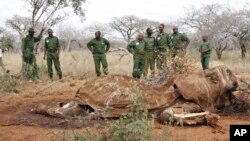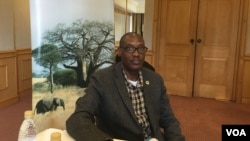The president of the African Wildlife Foundation has called on African governments to urgently address the issue of poaching, which he said is depriving the continent of its resources. But Zimbabwe says the international ban on the sale of ivory — which was imposed to discourage poaching — is hurting its interests.
Winding up a five-day visit to Zimbabwe on Friday, Kaddu Sebunya said poaching is depleting Africa of its vital natural resources in the same way the slave trade once did.
He said animal populations are dropping rapidly around the continent.
“We have been losing an average of 30,000 elephants annually. Many African countries in the last 20 years have lost all their rhino population. All. Zero left. It is worrying. Through poaching. Not through any legal mechanism. Our lion population has halved. And if we do not do anything around that, we are going to lose our lions in 20 years. And we need to something about it. Time is now,” Sebunya said.
According to the International Union for Conservation of Nature and Natural Resources, other animals on the decline in Africa include cheetahs and black rhinos.
The animals are important to Africa’s economy, helping to drive tourism.
But economic concerns also drive the poachers, who sell wildlife products such as tusks and rhino horn to meet demand abroad, mainly in Asia. Sebunya said something must be done to reduce demand for these products — especially ivory — as well as address the poverty and hunger that lures some Africans into poaching.
Zimbabwe has the continent’s second-largest elephant population, estimated at about 82,000. The number has dropped by about 6,000 in the last decade, partly because of poaching.
Like other African countries, Zimbabwe is taking steps to stop the decline. However, the government has refused to destroy the elephant tusks it has confiscated from poachers over the years, as Kenya recently did.
Zimbabwe’s Finance Minister Patrick Chinamasa spoke in parliament this week about the ivory:
“We have $9.6 billion worth of ivory in the country; sufficient to write off our debt. So this is the paradox of Africa. Rich Africa, poor Africans. Because the policies are coming from outside. And imposed on us. They do not have elephants but they become members of CITES to ban and stop us from disposing our own assets.”
CITES is the Convention on International Trade in Endangered Species of Wild Fauna and Flora, an international agreement that, among other things, bans the sale of ivory.
The ban was imposed to protect elephants. But Zimbabwe argues that its elephant population has grown beyond the country’s capacity.
During his visit to Zimbabwe, Sebunya said he would not comment on CITES but said he was happy that the country was scaling up efforts to fight poaching.











